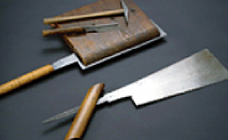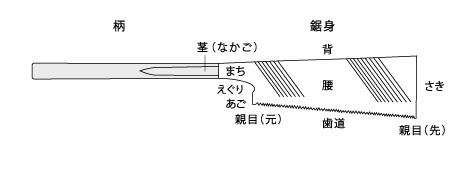Saw [nokogiri]
Saw
Saw

It is well known that saws are tools used when cutting trees. It is the most commonly used tool in conjunction with a chisel (flea) and plane (canna) among carpenter tools.
The saw is made of a steel saw body and a wooden handle. The part with the saw and teeth is called "saw teeth", and the side without it is called "back". In addition, the part close to the pattern is called "moto body (body)" and the tip is called "sume body". Generally, the saw body is thicker in the center waist than the saw teeth and back parts, and the bottom is thinner and wider, increasing the thickness and narrower as it approaches the body. This gives uniform strength to the whole saw body. In addition, the saw in Japan is generally cut when it is pulled. If you look around the world's carpentry tools, saws are pushed in most countries, so our saws are very rare.
The saw is also known as a tool of many kinds. First, it is broadly divided into "longitudinal saw" that grinds in the direction of the fiber of the tree and "lateral saw saw" that grinds at right angles from the direction of the fiber (see the explanation below). Since the Edo period, when the occupations were differentiated, various dedicated saws were born according to the purpose. For vertical grinding, there are Gagari and Kamoi saw saws, and for horizontal grinding, there are hole saws (nasal round saws), saws with torso, saws with saws, and pudding saws. In addition, saws with both vertical and horizontal grinding eyes on both sides of the saws that are often seen are called double-edged saws, and began to be used around 1897.
The saw is cut out of the steel plate, heat treatment is applied, and then drilled with a hammer to make it. Before the steel sheet became readily available, it was made by striking from ball steel, but it is said that it was difficult to make a uniform steel saw.

Name of each part of the saw
Basic information
Special Exhibition
Permanent exhibition